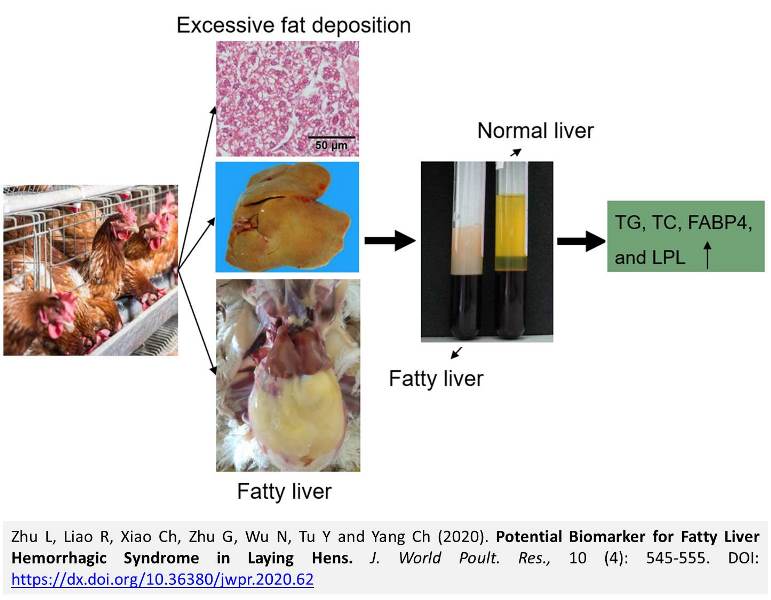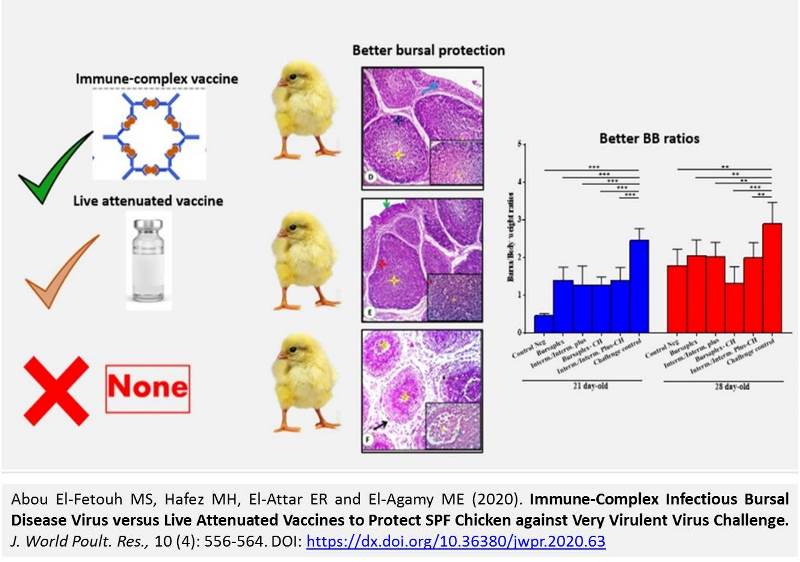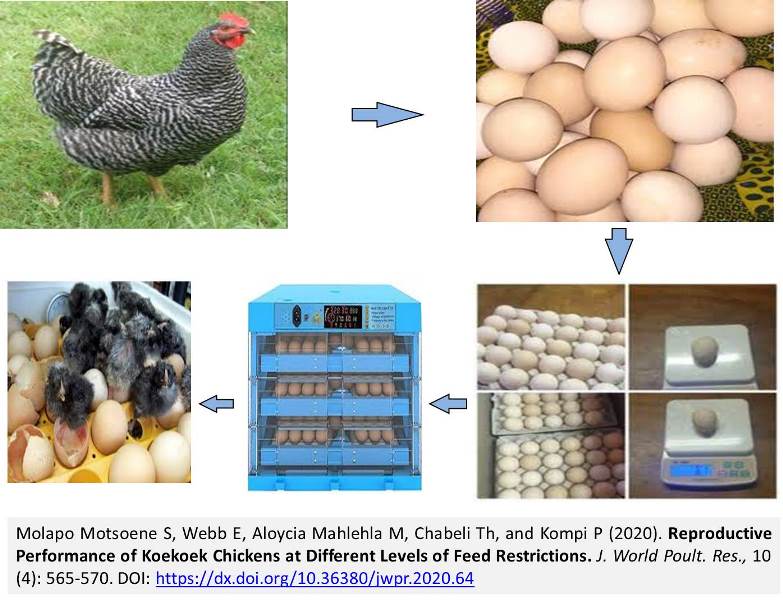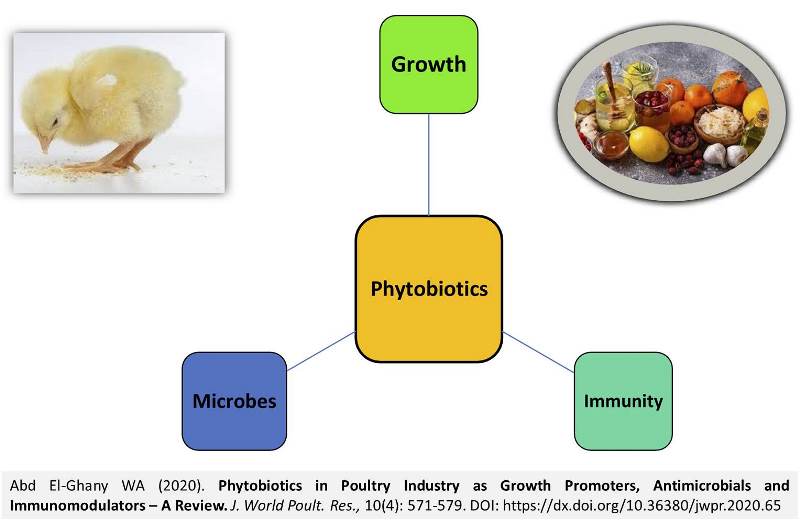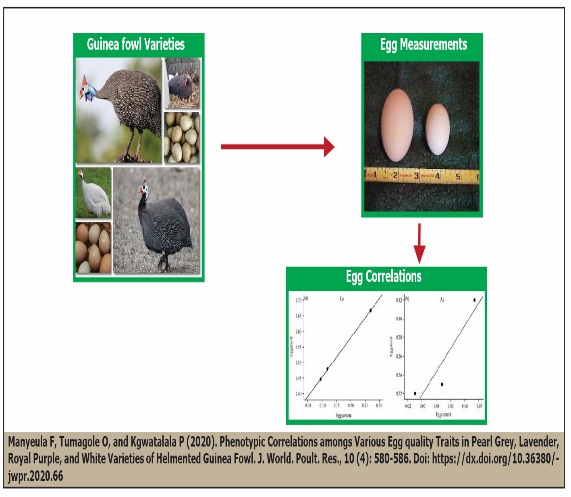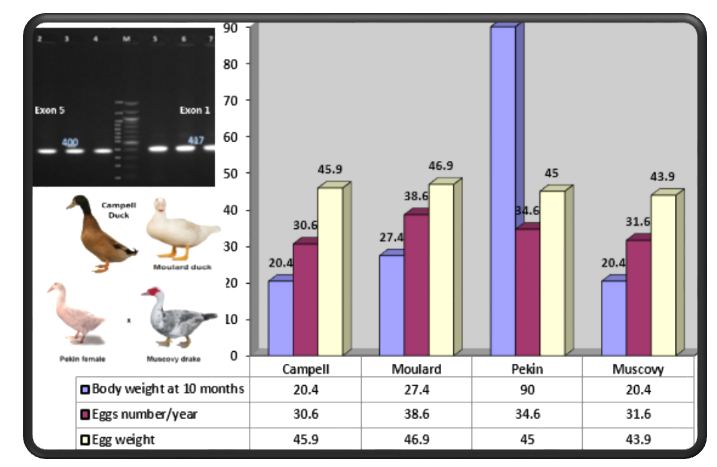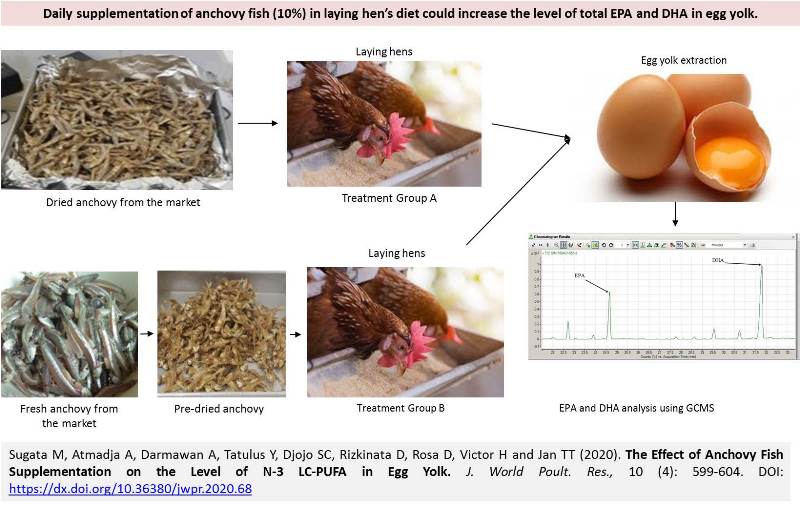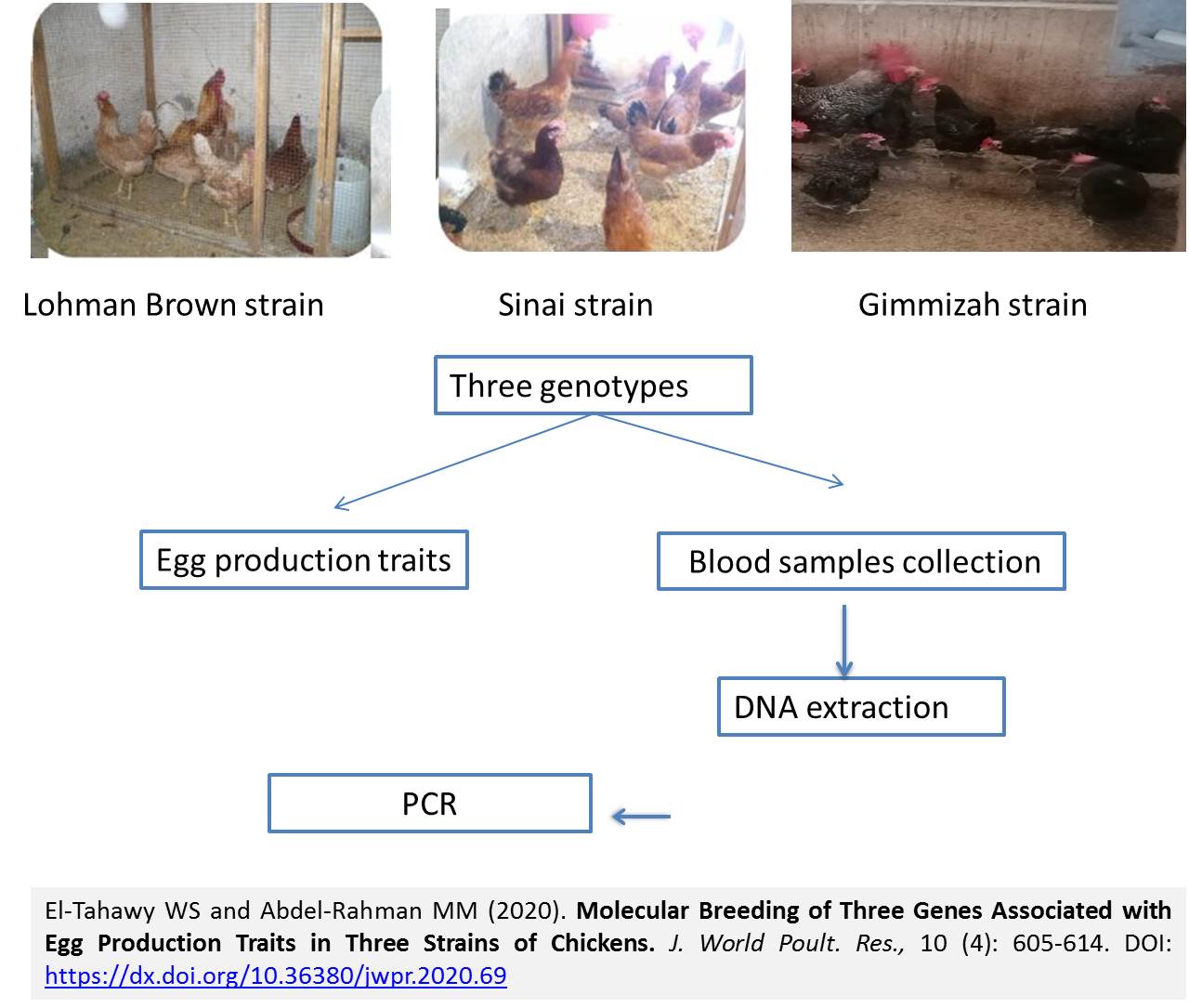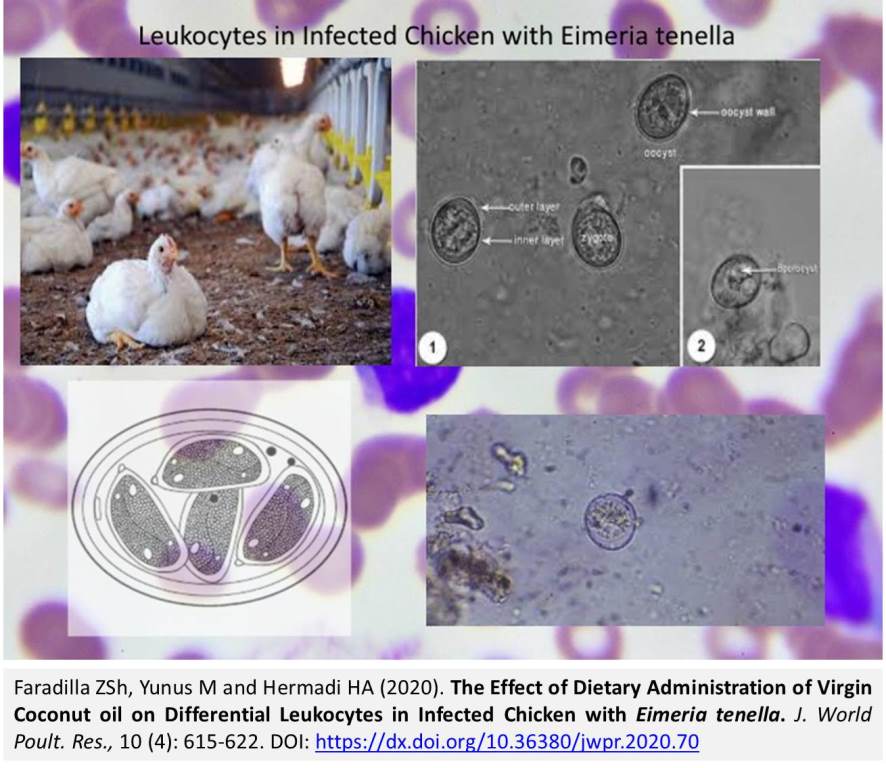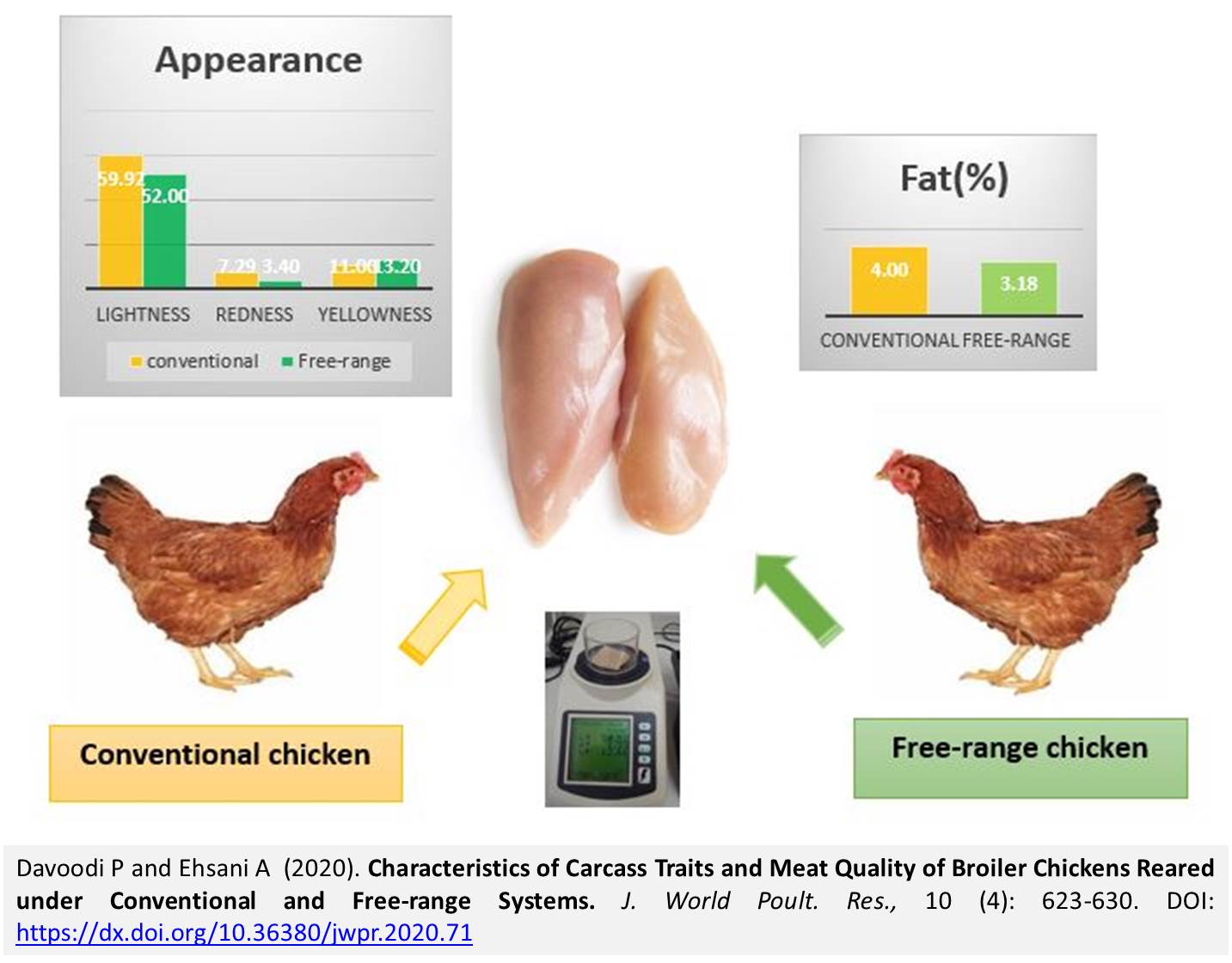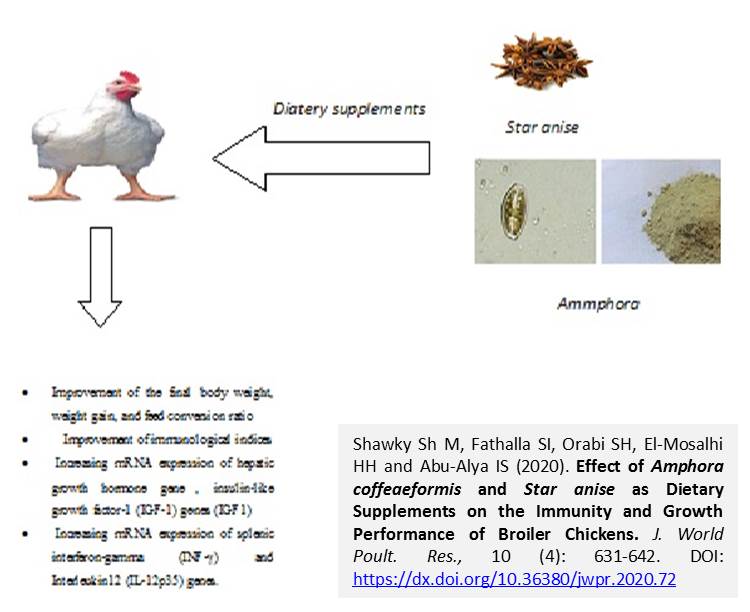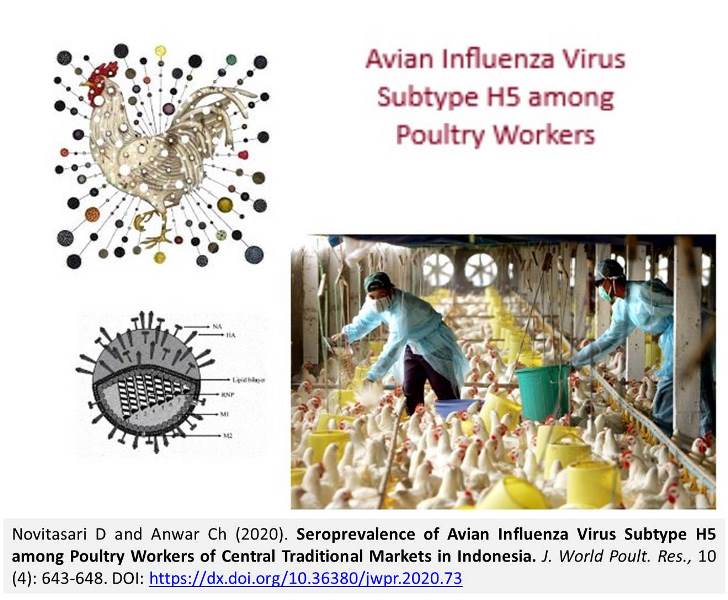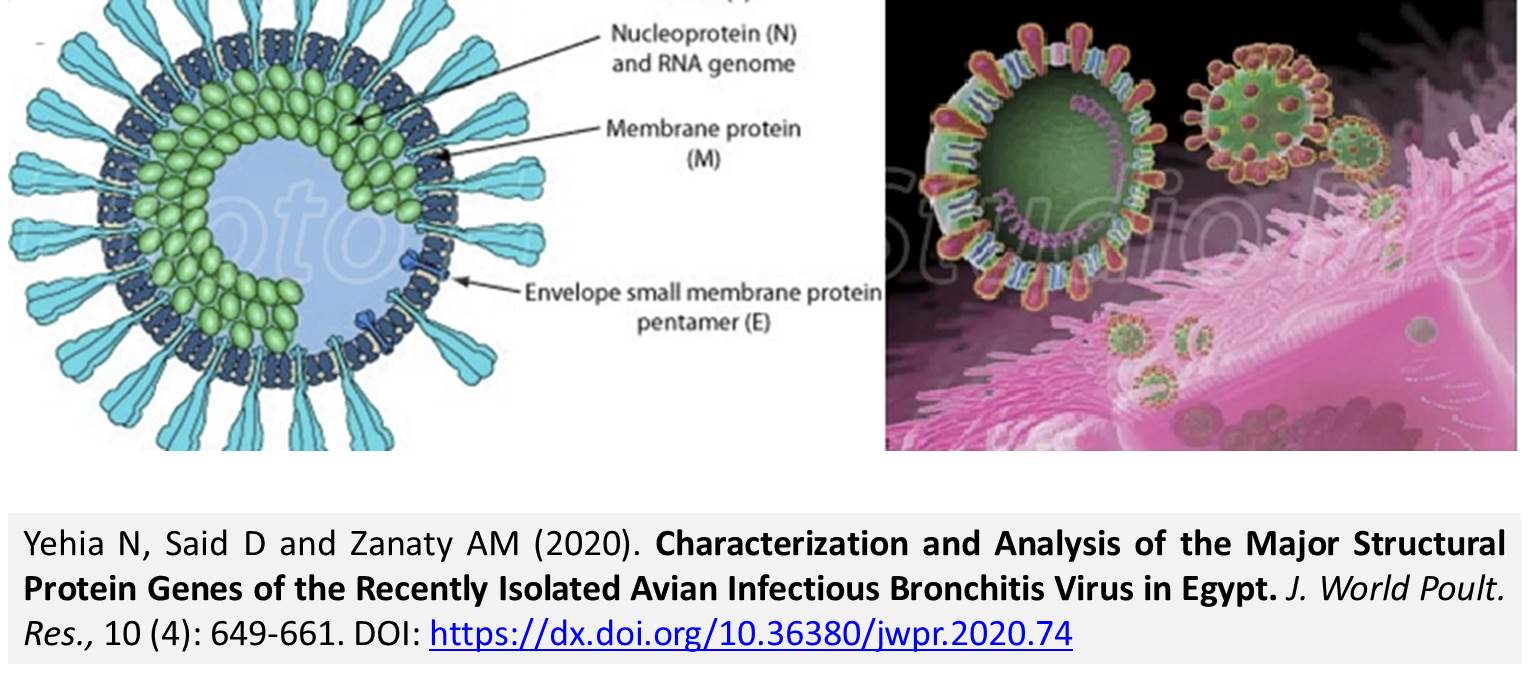Previous issue | Next issue | Archive
Volume 10 (4); December 25, 2020 [Booklet] [EndNote XML for Agris]
Potential Biomarker for Fatty Liver Hemorrhagic Syndrome in Laying Hens.
Zhu L, Liao R, Xiao Ch, Zhu G, Wu N, Tu Y and Yang Ch.
J. World Poult. Res. 10(4): 545-555, 2020; pii: S2322455X2000062-10
DOI: https://dx.doi.org/10.36380/jwpr.2020.62
ABSTRACT: Fatty liver hemorrhagic syndrome is more common in laying hens with excess body weight (BW) and in the middle and late phase of egg production. However, no specific biomarkers in chickens can be used to diagnose liver steatosis or liver injury. The present study aimed to assess whether BW can be used to predict fatty liver in aged laying hens. This study also searched for potential plasma FLHS biomarkers. For these purposes, correlation among BW, relative weight of liver and abdominal fat, and plasma markers were analyzed in Hy-line brown laying hens. Furthermore, plasma levels of potential biomarkers were analyzed during the formation of fatty liver. Concentrations of triglycerides and total cholesterol were positively associated with BW in aged laying hens, while liver fat deposition was similar among chickens with different BW, indicating that BW cannot be used as the only criterion to discriminate aged laying hens with liver steatosis. A trend of increasing triglyceride, total cholesterol, fatty acid-binding protein 4 (FABP4), and lipoprotein lipase levels was found as age increased, and they were positively associated with BW indicating that they might be risk markers for FLHS in laying hens. The findings indicated that the plasma level of FABP4 was positively associated with the severity of fatty liver in aged laying hens. All the above results suggested that FABP4 might be a potential diagnostic indicator for FLHS.
Key words: Biomarker, Egg production, Fatty liver, Laying hens, Poultry
[Full text-PDF] [XML] [Crossref Metadata]
Immune-Complex Infectious Bursal Disease Virus versus Live Attenuated Vaccines to Protect SPF Chicken against Very Virulent Virus Challenge.
Abou El-Fetouh MS, Hafez MH, El-Attar ER and El-Agamy ME.
J. World Poult. Res. 10(4): 556-564, 2020; pii: S2322455X2000063-10
DOI: https://dx.doi.org/10.36380/jwpr.2020.63
ABSTRACT: In this study infectious bursal disease (IBD) vaccinations were evaluated against very virulent IBD (vvIBDV) challenge and were compared. A total of 120-day-old white Leghorn SPF chickens were divided into 6 groups (each was 20 birds). Two groups were vaccinated on either day 1 with an immune-complex vaccine. The second groups were vaccinated at days 9 and 14 of age using intermediate and intermediate plus IBD vaccines, respectively the balance groups are controls. All vaccines were administered according to the manufacturer's instructions. The challenge was conducted on the 16 days of age using 105 EID50 /0.1 ml of a vvIBDV strain via the oculonasal route. The antibody immune response was monitored in all groups at 14, 21, 28, and 35 days of age. The performance, bursal gross lesions, challenge virus detection, and bursal histopathology were evaluated in vaccinated non challenged and vaccinated challenged birds at days 21 and 28 of age. All vaccinated groups were protected against the vvIBDV challenge compared to 40% mortality in the challenge control group. Both the immune-complex and live attenuated IBD vaccine groups showed similar bursa body weight (BB) ratios compared to the negative control group. The immune-complex vaccinated groups antibody titers were significantly higher except on 28th day of age. Upon challenge, the intermediate/intermediate plus vaccinated challenged group showed higher antibody titers at 21 and 35th with the challenge virus detection and quantification on day 28. The immune-complex vaccinated challenged group developed milder bursal histopathology signs but no differences between the 2 vaccine programs were seen. It can be understandable, the use of either immune-complex vaccine at day-old or early vaccination with intermediate followed by intermediate plus live attenuated IBD vaccines induced protective antibody titers and protect chickens against an early vvIBDV challenge. The suggested schedules need further evaluation in commercial broilers with maternal derived IBD antibodies to simulate field conditions.
Keywords: Immune-Complex vccine, Infectious Bursal Disease, Live Attenuated Vaccine, SPF Chicken
[Full text-PDF] [XML] [Crossref Metadata]
Reproductive Performance of Koekoek Chickens at Different Levels of Feed Restrictions.
Molapo Motsoene S, Webb E, Aloycia Mahlehla M, Chabeli Th, and Kompi P.
J. World Poult. Res. 10(4): 565-570, 2020; pii: S2322455X2000064-10
DOI: https://dx.doi.org/10.36380/jwpr.2020.64
ABSTRACT: The objective of the present study was to determine the impact of the feeding levels on the reproductive characteristics of Koekoek chickens. A total of 270 Koekoek chickens were randomly assigned to 4 feeding level treatments in a completely randomized design. The four feeding level treatments were fully fed during the rearing and laying phase (AA), fully fed during the rearing phase and restricted feeding during the laying phase (AR), restricted feeding during the rearing phase and fully fed during the laying phase (RA), and restricted both during the rearing and laying phase (RR). The General Linear Model procedure (SPSS software, version 17) was used to analyze the data set. The pubic bone measurements were 23.6, 25.1, 16.1, and 15.1 mm for chickens that received AA, AR, RA, and RR treatments, respectively, at 18 weeks of age. At 32 weeks of age, chickens given AA and RA treatments had wider pubic bones than chickens given AR and RR treatments. Combined ova and oviduct weights were higher in the fully fed chickens at 18 weeks of age. Koekoek chickens in AA treatment had the highest average egg production. Chickens given AR treatment had lower average egg weights than those given AA, AR, and RR treatments. Chickens treated with AA and AR reached puberty earlier than those that were treated with the RA and RR treatments. The eggs produced by chickens given RR treatment had a higher average hatching percentage. The lowest percentage of hatches was observed in chickens that were fed ad libitum during the rearing phase. In conclusion, the feed restriction only during the rearing phase improved the reproduction performance of Koekoek chickens.
Keywords: Egg weight, Fully fed, Hatchability, Koekoek, Laying percentage, Oviduct, Pubic bone, Restricted
[Full text-PDF] [XML] [Crossref Metadata]
Phytobiotics in Poultry Industry as Growth Promoters, Antimicrobials and Immunomodulators – A Review.
Abd El-Ghany WA.
J. World Poult. Res. 10(4): 571-579, 2020; pii: S2322455X2000065-10
DOI: https://dx.doi.org/10.36380/jwpr.2020.65
ABSTRACT: Due to the hazardous use of antimicrobials in poultry production sector, development of drug resistance have become a worldwide problem. Therefore, using biotic or natural products, such as phytobiotics (phytogenics or botanicals) have received a great attention as antibiotic substitutes. The use of phytobiotics or their constituents have been considered as a relatively new class of natural herbs that gained popularity and acceptability among poultry farmers. The incorporation of several types of phytobiotic additives in poultry feed have proved their ability to enhance the productive performance of broilers as well as layers. Moreover, phytbiotics presented great efficacy in counteracting intestinal pathogenic microorganism while maintaining the population of normal inhabitant beneficial microflora. Immunostimulatory effect on both humoral and cellular immunity as well as antioxidant properties were recorded as characters of phytobiotics. Therefore, this review article aimed to give a spotlight on the uses of different types of phytobiotics as poultry dietary additives to improve the productive parameters, reduce the pathogenic intestinal bacteria, and potentiate the immune response, especially after vaccination processes.
Keywords: Antimicrobial, Immunity, Performance, Plants, Poultry
[Full text-PDF] [XML] [Crossref Metadata]
Phenotypic Correlations among Various Egg Quality Traits in Pearl Grey, Lavender, Royal Purple, and White Varieties of Helmeted Guinea Fowl.
Manyeula F, Tumagole O and Kgwatalala P.
J. World Poult. Res. 10(4): 580-586, 2020; pii: S2322455X2000066-10
DOI: https://dx.doi.org/10.36380/jwpr.2020.66
ABSTRACT: Guinea fowls are increasingly popular in Botswana since they not only provide an alternative to access protein in the form of eggs and meat but also become a good source of income for the peasants. There are different varieties of Guinea fowl in Botswana, including pearl grey, lavender, royal purple, and white. Indeed, there is a need to conduct more studies related to the phenotypic correlations among egg quality traits in different varieties of helmeted guinea fowl found in Botswana. Therefore, the present study was targeted toward the evaluation of both the external and internal quality characteristics of the four different varieties of the domesticated helmeted guinea fowl found in Botswana. In this regard, a total of 150 eggs were collected from the so-called varieties of domesticated helmeted guinea fowl. The egg weight was positively and significantly correlated with egg length, egg width, shell weight, egg surface area, and egg volume; however, the egg weight was negatively correlated with egg shape index. Of the four varieties of domesticated helmeted guinea fowl found in Botswana, the white variety had the strongest correlation coefficients with various external egg quality traits and different internal egg quality characteristics. The lavender variety had the highest correlation coefficients with internal and external egg quality traits. It seems that the selection for higher egg weight as is the case in the current egg grading system can lead to the greatest improvements in other egg quality characteristics in the white and lavender varieties, compared to the pearl grey and royal purple varieties. Therefore, the lavender and white varieties are the potential candidates for the possible selection of layer-type guinea fowl varieties.
Keywords: Botswana, Egg traits, Guinea fowl, Layer-type
[Full text-PDF] [XML] [Crossref Metadata]
Polymorphism of the Prolactin Gene in Egyptian Duck Breeds.
Sabry NM, Mabrouk DM, Abdelhafez MA, El-Komy EM and Mahrous KF.
J. World Poult. Res. 10(4): 587-598, 2020; pii: S2322455X2000067-10
DOI: https://dx.doi.org/10.36380/jwpr.2020.67
ABSTRACT: In avian, the prolactin hormone triggers and regulates ovarian follicle development. This study aims to detect the Prolactin (PRL) gene polymorphisms (exons 1and5) in four Egyptian duck breeds, namely Campbell, Moulard, Muscovy, and Pekin using PCR-RFLP technique and sequence analysis. It also investigated the association of this gene with egg production, egg weight, and body weight. The present results revealed that PRL gene exon 1 and part of intron 1 showed two alleles A and B (polymorphic) in each of Campbell and Moulard, however, Muscovy and Pekin had only one allele (monomorphic). The allele A was more dominant with frequencies of 0.70, 0.60, and 1.00, compared to the allele B (0.30, 0.40, and 0.00) for Campbell, Moulard, and Muscovy, respectively. For Pekin, the allele B only appeared with the frequency of 1.0. Ducks with the high frequency of allele A were superior at egg weight, compared to others. Furthermore, for PRL gene exon 5, there were two alleles G and C (polymorphic) in Campbell, Moulard, and Muscovy, however, Pekin had only one allele (monomorphic). The allele G was more dominant (0.15, 0.74, 0.0, and 0.84) than the allele C (0.85, 0.26, 1.0, and 0.15) for Campbell, Moulard, Pekin, and Muscovy, respectively. Ducks having a high frequency of allele C were superior at egg production. Furthermore, there were many single nucleotide polymorphisms (SNPs) in the sequences in all breeds. The utmost ones exist at the restriction sites of XbaI enzyme for the amplified fragment, in the promotor, exon 1 and intron 1 (T378C in intron 1), and DraI enzyme for that in exon 5 (A5871G in exon 5).
Keywords: Duck, Genetic polymorphism, Genotyping, Prolactin gene
[Full text-PDF] [XML] [Crossref Metadata]
The Effect of Anchovy Fish Supplementation on the Level of N-3 LC-PUFA in Egg Yolk.
Sugata M, Atmadja A, Darmawan A, Tatulus Y, Djojo SC, Rizkinata D, Rosa D, Victor H and Jan TT.
J. World Poult. Res. 10(4): 599-604, 2020; pii: S2322455X2000068-10
DOI: https://dx.doi.org/10.36380/jwpr.2020.68
ABSTRACT: Since the recommended daily intake of n-3 LC-PUFA is rarely met, interest in food enrichment has been increasing. It is known that dietary supplementation could alter the level and type of PUFA in the egg. Hence, the present study focused on the enrichment of egg yolk by the addition of 10% anchovy fish to the chicken diet. Based on gas chromatography analysis, dried and pre-dried anchovy from Indonesia contained a considerable amount of total eicosapentaenoic acid (EPA) and docosahexaenoic acid (DHA), which was 60.10 g and 68.80 mg/100 g, respectively. After 24 days of anchovy supplementation, DHA-rich anchovy fish oil diet caused a significant increase of DHA but not EPA in egg yolk. Hens fed with anchovy could produce eggs with a higher amount of total EPA and DHA, which was up to 155.98-201.53%, as compared to control eggs. Furthermore, the sensory profile of control and enriched eggs was also evaluated. There was no significant difference in texture, aroma, flavor, and appearance between control and enriched eggs. In conclusion, this study indicated that anchovy fish supplementation could increase the level of EPA and DHA in egg yolk without causing any sensory changes in the yolk.
Keywords: Anchovy, DHA, Egg yolk, Enrichment, EPA
[Full text-PDF] [XML] [Crossref Metadata]
Molecular Breeding of Three Genes Associated with Egg Production Traits in Three Strains of Chickens.
El-Tahawy WS and Abdel-Rahman MM.
J. World Poult. Res. 10(4): 605-614, 2020; pii: S2322455X2000069-10
DOI: https://dx.doi.org/10.36380/jwpr.2020.69
ABSTRACT: Breeding programs play an important role in increasing the performance of chickens. The poultry industry regards growth and reproduction as the two most economically valued characteristics for providing adequate animal proteins. Genetic variations are the basis of animal breeding. The present study was conducted on three genes, including Prolactin, 3-Hydroxy-3-Methylglutaryl-Coenzyme A Reductase (HMGCR), and Gonadotropin-Releasing Hormone Receptor (GNRHR). DNA was isolated from 48 chickens taken from three strains Lohmann Brown (17), Sinai (24), and Gimmizah (7) for Prolactin, HMGCR, and GNRHR gene amplification by using the PCR protocol. Electrophoresis was performed on the PCR products and the bands were viewed on a transilluminator. The size of the Prolactin gene, HMGCR, and GNRHR were 154, 675, and 210 bp, respectively. For the Sinai strain, five bands for Prolactin, two bands for HMGCR, and six bands for GNRHR were found while for the Lohmann Brown strain, five bands of Prolactin gene, three bands for HMGCR, and five bands for GNRHR were found. Regarding the Gimizah strain, two bands were found for Prolactin and GNRHR genes and there was only one band for the HMGCR gene. The Lohmann Brown strain respectively matured 13 and 91 earlier than Gimizah and Sinai strains with a higher egg number during the first 90 days.
Keywords: Breeding, Chickens, Egg production, GNRHR gene, HMGCR gene, Prolactin gene, PCR
[Full text-PDF] [XML] [Crossref Metadata]
The Effect of Dietary Administration of Virgin Coconut oil on Differential Leukocytes in Infected Chicken with Eimeria tenella.
Faradilla ZSh, Yunus M and Hermadi HA.
J. World Poult. Res. 10(4): 615-622, 2020; pii: S2322455X2000070-10
DOI: https://dx.doi.org/10.36380/jwpr.2020.70
ABSTRACT: Coccidiosis is the main problem in poultry diseases. It is caused by the parasite Eimeria tenella, which induce the immune response of leukocyte. Anticoccidial drugs are administered in the poultry feed to control coccidiosis. However, taking medication for a long time can lead to resistance. Recent studies have indicated that Virgin Coconut Oil (VCO) has some benefits, including anti-inflammatory effects. The present research aimed to identify the effect of VCO at the different doses in improving the various leukocyte counts of chickens infected with E. tenella. Male chickens were divided into five groups (T0, T1, T2, T3, and T4) and treated for 28 days. T0 was neither infected with E. tenella nor get treatment, T1 was only infected with E. tenella, T2 was treated with 5 ml/kg VCO feed and had E. tenella infection, T3 was treated with 10 ml/kg VCO feed and had E. tenella infection, and T4 was treated 20ml/kg VCO feed and had E. tenella infection. Differential leukocyte was counted with a blood cell counter. The data obtained were analyzed using ANOVA and Duncan’s Multiple Range Test. The results indicated that a dose of 10 ml/kg feed and 20ml/kg feed of VCO could improve the differential leukocyte counts of chickens infected with E. tenella by maintaining the counts of basophil, eosinophil, heterophil, monocyte, and lymphocyte in the normal range. The present study concluded that VCO by a dose of more than 10 ml/kg would improve the differential leukocyte counts of chickens infected with E. tenella.
Keywords: Differential leukocyte count, Eimeria tenella, Virgin Coconut Oil
[Full text-PDF] [XML] [Crossref Metadata]
Characteristics of Carcass Traits and Meat Quality of Broiler Chickens Reared under Conventional and Free-range Systems.
Davoodi P and Ehsani A.
J. World Poult. Res. 10(4): 623-630, 2020; pii: S2322455X2000071-10
DOI: https://dx.doi.org/10.36380/jwpr.2020.71
ABSTRACT: Alternative chicken production systems have become popular in recent years due to animal welfare criteria and consumer’s perceptions. General beliefs express that the meat quality of chicken reared under free-range systems is better than that of chickens under conventional production conditions. The aim of this study was to compare the meat quality and carcass traits of chickens raised in conventional and free-range systems. Either conventional or free-range systems used meat-type Hubbard JA57 birds with a slaughter age of approximately 78 days. For assessing carcass traits and meat quality, six male chickens were selected from each system. The meat quality parameters, pH at 45 minutes, ultimate pH, color coordinates, drip loss, cooking loss, and water-holding capacity were measured. Furthermore, proximate parameters, such as crude protein, total fat, and crude ash were determined. There were no significant differences in main carcass yield and breast muscles between chickens reared in two systems, however, color values dramatically were influenced by rearing systems. Breast muscle samples from birds reared under the conventional system had a smaller hue angle and saturation value than those from the free-range birds. Moreover, the drip loss parameter was significantly higher in free-range chickens. The ash and protein contents of breast muscles were similar although raw breast meat from free-range birds had significantly lower fat content. The results prove that a free-range rearing system can modify the appearance, color values, and fat content of chicken meat and it can be a part of the interests of meat production consumers.
Keywords: Broiler chickens, Free-range, Hubbard JA57, Intensive rearing system, Meat quality
[Full text-PDF] [XML] [Crossref Metadata]
Effect of Amphora coffeaeformis and Star anise as Dietary Supplements on the Immunity and Growth Performance of Broiler Chickens.
Shawky Sh M, Fathalla SI, Orabi SH, El-Mosalhi HH and Abu-Alya IS.
J. World Poult. Res. 10(4): 631-642, 2020; pii: S2322455X2000072-10
DOI: https://dx.doi.org/10.36380/jwpr.2020.72
ABSTRACT: The present study was designed to evaluate the impacts of daily dietssupplemented with Amphora coffeaeformis and Star anise on growth performance and immunity of Cobb broiler chickens. Amphora coffeaeformis is considered a potent free radical scavenger due to the presence of β-carotene and fucoxanthin, which are used widely as food additives. Star Anise has a natural antioxidant, which can also be used for the chemo-prevention of disease occurring due to oxidative deterioration. A total of 270 broiler chickens were divided into three groups, each with three replicates of 30 birds. The control group (G1) was given the basal diet, the Amphora group (G2) received Amphora in a dose of 1g/Kg in the ration, and the Star anise group (G3) received Star anise in a dose of 2g /Kg in the ration. The results indicated that Amphora and Star anise significantly improved the final body weight, weight gain, and feed conversion ratio, total white blood cells count, phagocytic activity percentage, phagocytosis index in plasma, IgM, IgG, and A/G ratio in serum. In addition, Amphora and Star anise significantly increased mRNA expression of hepatic growth hormone gene, insulin-like growth factor-1 (IGF-1) genes (IGF1), and mRNA expression of splenic interferon-gamma (INF-γ) and Interleukin 12 (IL-12p35) genes from broiler chickens, compared to the control group. In conclusion, the use of fed additives, such as Amphora coffeaeformisand Star anise in the diet of broiler chickens for 35 days was sufficient to improve broiler growth performance and could modulate their immunity.
Keywords: Amorphacoffeaeformis, Broiler chickens, Diet supplementation, Growth performance, Immunity, Star anise
[Full text-PDF] [XML] [Crossref Metadata]
Seroprevalence of Avian Influenza Virus Subtype H5 among Poultry Workers of Central Traditional Markets in Indonesia.
Novitasari D and Anwar Ch.
J. World Poult. Res. 10(4): 643-648, 2020; pii: S2322455X2000073-10
DOI: https://dx.doi.org/10.36380/jwpr.2020.73
ABSTRACT: Avian Influenza (AI) has been spread rapidly in almost all the provinces of Indonesia by the end of 2007, and it has become endemic. Avian Influenza viruses can be infecting to human from direct or indirect contact with the infected or dead poultry, and a visit to the wet poultry market in the neighborhood. Seroprevalence studies can be used to identify the clinical key, epidemiological studies, and the spread of AI viruses in humans. The aim of present study was to investigate the seroprevalence of Avian Influenza (AI) virus, subtype H5 among poultry workers at the central traditional market in industrial. To meet the mentioned demand, 26 blood samples were collected from the poultry workers via the median cubital vein. The antibody titer was examined using Hemagglutination Inhibition (HI) assay using H5 antigen from duck licensed under A/Dk/Indonesia/AU-78/12 (H5N1) and three kinds of red blood cells taken from horse, chicken and guinea pig. The serum samples were added with Receptor Destroying Enzyme (RDE) with a ratio of 3:1 (v/v) for an overnight, and pretreated with 10% of red blood cells before the HI assay was conducted. Based on the findings, it can be concluded that the percentage of seroprevalence of Avian Influenza (AI) virus, subtype H5 among poultry workers at central traditional market was 0%. Thirteen samples showed a negative result of the HI test. All of the workers’ blood serum obtained less than 24 antibody titer from the HI test. As the results showed, the research on the poultry workers in the traditional market was carried out, and it obtained negative results; all the workers were not infected with the Avian Influenza virus. In other words, Avian Influenza is not meaningful in poultry farm workers in Sidoarjo suburb traditional farms.
Keywords: Avian Influenza, Poultry workers, Seroprevalence, Traditional market.
[Full text-PDF] [XML] [Crossref Metadata]
Characterization and Analysis of the Major Structural Protein Genes of the Recently Isolated Avian Infectious Bronchitis Virus in Egypt.
Yehia N, Said D and Zanaty AM.
J. World Poult. Res. 10(4): 649-661, 2020; pii: S2322455X2000074-10
DOI: https://dx.doi.org/10.36380/jwpr.2020.74
ABSTRACT: Infectious Bronchitis Virus (IBV) is a severe infectious disease affecting chickens and causing serious economic loss. Although several studies have been conducted to characterize HVRs-S1 (Hyper-Variable Regions of Spike 1 gene) in Egypt, few of which aimed to characterize the major structural protein genes. In the present study, the genetic characterization of the major structural protein genes was carried out in 10 isolates selected from six governorates in 2019. Phylogenetically, the S1 gene was clustered into genotype GI-23 (variant II), with seven viruses that were clustered into Egy/Var II occurring in two subgroups (I, II) when aligned with previously isolated Egyptian strains. It had a specific character of 40 Amino Acids (AA) mutations except for IBV/EG/CV32/2019, which had 50 AA mutations, specifically in HVRs regions (HVRI, II, and III). The other three strains were clustered into Egy Var I with 17 AA mutations except IBV/EG/F859/ 2019, which had 15 AA mutations, compared to IBV/CU/4/2014 reference strain. The examined isolates had an additional glycosylation site at position 280 and one was missing at position 139 with the exception of two strains that only had an additional one, compared to IBV/CU/4/2014. The viruses in this study differed genetically from various vaccine seeds in the range of 69-83%. The Nucleocapsid, genetically characterized in the group of variant II (Egy/Var II) and the glycoprotein membrane genes genetically characterized in the variant group in a new sub-group with 11 and 9 AA mutations, respectively. The recombination event was only detected in the S1 gene in two isolates of IBV/EG/CV32/2019 and IBV/EG/F859/2019 from D274 and QX, respectively. In this regard, it is important to conduct continuous surveillance, pathogenicity study, and vaccine efficacy evaluation.
Keywords: Characterization, Infectious bronchitis virus, Major structure protein, Matrix, Nucleoprotein, Spike
[Full text-PDF] [XML] [Crossref Metadata]
Previous issue | Next issue | Archive
![]() This work is licensed under a Creative Commons Attribution 4.0 International License (CC BY 4.0).
This work is licensed under a Creative Commons Attribution 4.0 International License (CC BY 4.0).

